|
|
 |
|
March 28, 2012
A couple of nights ago it was too cold and rainy to go outside and grill the salmon, so I decided to rely instead on a technique that’s an old favorite, roasting the salmon in the oven with butter and slivered almonds. It’s a slightly retro dish, very simple and quick to make, and very satisfying, but I wasn’t sure about what wine to serve with it. Of course Pinot Noir has become everyone’s current favorite to complement salmon, but I think this pairing works best with grilled salmon, not roasted. And besides, so many Pinots today are too sweet and fruity to 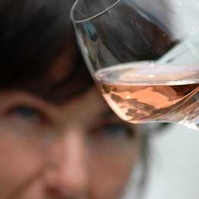 really balance the delicacy of fresh salmon. really balance the delicacy of fresh salmon.
Sometimes Chardonnay, and aromatic whites such as Viognier, match well with salmon but often these white wines can be slightly misaligned with it, accentuating the fishy side of this otherwise un-fishy seafood. Someone once explained to me that this is particularly the case when the vines have grown in iron-rich soil. I’ve no reason to doubt this, but when we buy a bottle of wine how are we supposed to evaluate the mineral content of the soils in which the grapes were raised?
Then inspiration struck: let’s try Rosé with the salmon! If nothing else, I figured that the peachy-pink wine would be a gorgeous spring color match with the fish. Since I was pretty sure that a very dry but deeply flavorful Rosé had the best chance at highlighting the virtues of the dish, my instinct was to turn to Provence. This French region, which stretches from the 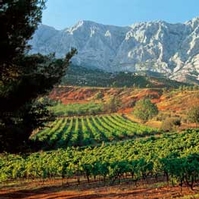 Cote d’Azur in the east (along the Italian border) to the Rhône River in the west, is roughly 150 miles wide. It lays claim to being the birthplace of Rosé, and while its wines were woefully neglected in the United States for a long time, things have, happily, changed, as exports of Rosé from Provence jumped 62% by volume last year. In fact, Provence is now the fastest-growing French region in the exportation of wine to the U.S. market. Cote d’Azur in the east (along the Italian border) to the Rhône River in the west, is roughly 150 miles wide. It lays claim to being the birthplace of Rosé, and while its wines were woefully neglected in the United States for a long time, things have, happily, changed, as exports of Rosé from Provence jumped 62% by volume last year. In fact, Provence is now the fastest-growing French region in the exportation of wine to the U.S. market.
I am certainly not the only lover of French wine for whom the word “Provence” shouts out “Rosé!” And since nothing says Rosé quite like Tavel, I selected a bottle of Chateau d’Aqueria Tavel, 2010 (imported by Kobrand, the wine sells for about $18). And yes, the luminous pink wine shimmering in glasses on the table alongside the salmon was indeed a beautiful sight, but more importantly the wine and food marriage was very much what I’d hoped for. Fragrant and fruity, the Rosé had just the right robust body, deep flavor and cleansing acidity to strike a sensory balance with the silky salmon in all its buttery, nutty goodness.
Here’s the simple recipe:
SALMON ROASTED WITH ALMONDS
You can use farmed salmon if you like, but for many reasons I prefer wild (preferably line caught) salmon, especially because it is leaner and more flavorful. You can ask the fishmonger to skin the filet if you’d like, but this isn’t really necessary since you can just lift the fish off the skin after its cooked.
Serves 2-4
3 tablespoons butter
½ cup slivered almonds
1 tablespoon Canola or other neutral vegetable oil
About 1 ½ pounds salmon filet
Salt and pepper
Finely minced parsley (optional)
1 lemon, cut in wedges
Preheat the oven to 400.
In a small skillet, melt the butter and cook the almonds over medium heat, stirring constantly, until the butter is lightly browned and some of the almonds have begun to color.
Distribute the oil over the bottom of a baking dish and place it in the heated oven for about 5 minutes. Season the fish with salt and pepper, then place it skin side down (if it hasn’t been skinned) in the hot dish and spoon the nuts and butter over the top. Bake, uncovered, for about 10 minutes, then check it for doneness. Put it back in the oven, if necessary, until it is just cooked through. Sprinkle with parsley if desired, and serve immediately, garnished with lemon wedges.
Posted by Marguerite Thomas at 11:10 AM
|
|
March 21, 2012
To celebrate a significant birthday this year, my friend Georgia is going on a trip to South Africa.
“For the wine?” I asked when she told me about her travel plans.
She stared at me. “Wine? No, I’m going for the wild animals and beautiful scenery. They have wine in South Africa?”
Not only does this brief dialogue illustrate how narrowly wine-centric my own view of the world is, it also suggests that South Africa’s wines are not as widely known as they deserve to be. 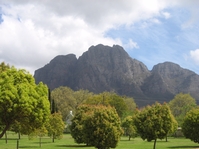 Although she’s a relatively sophisticated wine drinker, Georgia’s lack of knowledge about the wines of South Africa is hardly unique. Although she’s a relatively sophisticated wine drinker, Georgia’s lack of knowledge about the wines of South Africa is hardly unique.
Yes, they do have wine in South Africa, and if you aren’t already familiar with it, you’re missing out on one of the world’s most fascinating wine regions. South Africa, it is regularly counted among the top ten wine producing countries in the world, and it is hardly a newcomer to the wine business. Wine has been made here since the 1600s, although the earliest European settlers, who hailed from Holland, had little tradition of viticulture and winemaking. But with the arrival of the French Huguenots around 1680 the emerging wine industry gained momentum in both quantity and quality.
It has been far from a smooth journey across the centuries, with the worst bump in the road occurring during the political and social upheavals between 1948 and 1994, when South Africa’s wines virtually disappeared from the worldview. Then, with the end of apartheid in 1994 the forward thrust accelerated. Today, wines from South Africa, once considered generally coarse and rustic, routinely garner praise from critics across the globe. Of course there is always room for improvement, but isn’t that pretty much the case everywhere?
The heart and soul of the country’s wine growing is around Cape Town. Among the nation’s  wine districts are Paarl, Costantia, Western Cape, Walker Bay, Elgin, Oliphant, and Orange Rivers. Stellenbosch, located about 30 miles east of Cape Town, is perhaps the best-known South African wine region, and it also boasts the country’s oldest wine trail, founded in 1971. A lovely tree-shaded town, Stellenbosch is noted for its fine examples of Cape Dutch architecture as well as for its wines. Red wines dominate the Stellenbosch repertoire, especially Cabernet Sauvignon, Merlot, Shiraz and Pinotage. The best white wines from the region include Chenin Blanc, Chardonnay and Sauvignon Blanc. wine districts are Paarl, Costantia, Western Cape, Walker Bay, Elgin, Oliphant, and Orange Rivers. Stellenbosch, located about 30 miles east of Cape Town, is perhaps the best-known South African wine region, and it also boasts the country’s oldest wine trail, founded in 1971. A lovely tree-shaded town, Stellenbosch is noted for its fine examples of Cape Dutch architecture as well as for its wines. Red wines dominate the Stellenbosch repertoire, especially Cabernet Sauvignon, Merlot, Shiraz and Pinotage. The best white wines from the region include Chenin Blanc, Chardonnay and Sauvignon Blanc.
For wine lovers who haven’t delved into the diversity of South African wines, here are a few suggestions to begin your exploration. But these are merely suggestions, and I urge you to strike out on your own discoveries.
MAN VINTNERS Chenin Blanc, Coastal Region, 2011, $10, Imported by Vineyard Brands: With sweet, ripe melon and tropical fruit flavors backed by a refreshing tang of acidity, this is a perfect aperitif wine or a companion to simple seafood or poultry dishes.
HELDERBERG WIJNMAKERIJ Merlot, Stellenbosch, South Africa, 2009, $13, imported by Vineyard Brands: With juicy red fruit characteristics, and a specific kind of earthy character I’ve come to associate with many South African reds, this is an unusually sophisticated wine for the price. It’s well balanced, straightforward and moderate in all its aspects, including tannins, acidity, and sweetness.
ESSAY Shiraz, South Africa, 2009, $11, Imported by International Wine Imports: Another  attractively priced red, this blend of Shiraz, Cinsaut, Mourvèdre and Viognier is soft and sensuous, with distinct notes of sweet cherries held in savory balance by a swoosh of acid on the finish. attractively priced red, this blend of Shiraz, Cinsaut, Mourvèdre and Viognier is soft and sensuous, with distinct notes of sweet cherries held in savory balance by a swoosh of acid on the finish.
SOUTHERN RIGHT Pinotage, Hemel-en-Aarde Valley, South Africa, 2009, $27, imported by Vineyard Brands: A medium-light bodied wine with complex fruit flavors highlighted by earthineness and flashes of minerality. Pinotage, a crossing of Pinot Noir and Cinsault, is a favored South African wine grape. It may be somewhat of an acquired taste, but Southern Right’s version is a mellow and splendid example of the genre.
Posted by Marguerite Thomas at 6:11 PM
|
|
March 14, 2012
There is a quote attributed to Henry James claiming that the appreciation of literature involves two different kinds of emotion: Surprise and recognition. One might say that these diverse reactions also apply to wine appreciation. Some people only feel comfortable drinking familiar wines--the tried and true Cabernets, Chardonnays, Sauvignon Blancs and Pinot Noirs that are like old, trusted friends. Other enophiles seek out unfamiliar grape varieties and obscure 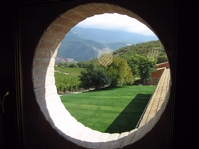 producers. These wine lovers go out of their way to sample wines from Macedonia or Massachusetts, Albania or Albuquerque, and some will insist, as a friend of mine does, that the best food to accompany high-end Champagne is popcorn. producers. These wine lovers go out of their way to sample wines from Macedonia or Massachusetts, Albania or Albuquerque, and some will insist, as a friend of mine does, that the best food to accompany high-end Champagne is popcorn.
Most of us, of course, fall somewhere in between the extremes. We may appreciate the occasional vinous surprise, but for the most part we rely on wine types and styles we recognize, and most of us are convinced that the best wine to drink with steak is something red and hearty. In other words, we go for recognition. But I’ve been thinking about the element of surprise recently following a flurry of unexpected encounters with bottles of wine from my home cellar that challenged some common expectations about wine.
Drink Only Current Vintages of White Wine? We’ve all heard that most white wines are best enjoyed as soon as the winery releases them to the market. This is when their fruit flavors are bright and their acid levels crisp and fresh. Notorious exceptions include some of the great white wines of Burgundy and Alsace, whose best wines develop added character and complexity with age, but for the most part white wines are best appreciated in their youth. Recently I was rooting through the wines stored in my basement in search of a red wine when I came across a bottle of 2006 Robert Stemmler Carneros Chardonnay that had mistakenly ended up next to that producer’s Pinot Noir. It had been lying there quiet and undetected for a couple of years--at least one year too long?--so I decided to chill it and serve it right away.
I was pretty sure the wine would still be decent; Robert Stemmler, after all, is a fine producer of California wines, and 2006 was a splendid vintage, but I was amazed by the absolute deliciousness of this very mature white wine. Its slightly musky perfume swirled tauntingly up from the glass, and the complex aromas and flavors evoking fresh ripe figs, honeyed apricots and a blessing of incense, were superb. I am not suggesting that every 2006 Chardonnay will deliver this same kind of pleasure, but in this instance excellent winemaking plus an excellent vintage led to a very pleasant surprise. (current vintage of Robert Stemmler Carneros Chardonnay is 2009, $34).
Drink Only Familiar Wines? Sampling little-known wines in a winery tasting room or wine bar is one thing, but spending money for a bottle of wine from your own neck of the woods can be a riskier proposition, unless your neck of the woods happens to be somewhere on the west 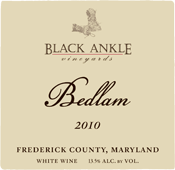 coast. I’ve been resisting opening the bottle of Black Ankle “Bedlam” that I picked up on a whim not too long ago. Made in Maryland, my home state, I didn’t know what to expect. I’ve been hearing good things about this fairly new estate, but still--Maryland?? coast. I’ve been resisting opening the bottle of Black Ankle “Bedlam” that I picked up on a whim not too long ago. Made in Maryland, my home state, I didn’t know what to expect. I’ve been hearing good things about this fairly new estate, but still--Maryland??
I finally opened Bedlam a couple of days ago and was utterly surprised by its voluptuous fruity/floral fragrance and flavors, and velvety, full bodied texture. Bedlam is a beguiling blend of Grüner Veltliner, Albariño, Viognier, Chardonnay and Muscat. You’ll probably have trouble finding it if you don’t live in the mid-Atlantic (where it sells for $28 at the winery and in a few retail stores), but why not give one of your own local wineries a try? You too might be pleasantly surprised.
Red Wine with Meat, White with Fish? This old maxim has been regularly debunked of late, but most of us continue to adhere to certain long held beliefs such as the aforementioned red wine with steak. For similar reasons we wouldn’t even think of serving white wine to accompany penne with sausage and tomato-based sauce. I served just such a dish for dinner recently, and on a crazy impulse I set a bottle of Muscat that I’d brought home from Alsace a couple of years ago on the table alongside the red wine I’d selected. Although it was certainly an unexpected food and wine pairing, everyone liked the oddball way the Muscat connected on the palate with the pasta, though a couple of guests found it somewhat distractingly fragrant and a tad too rich for the dish, and they preferred the red wine.
However, the rest of us were completely charmed by the way the silky Muscat connected with the pasta’s spicy flavors and soft texture, and how its sweetness wrapped around the spice in the sauce. What made the combination work was that the sauce--a “faux ragu” made quickly 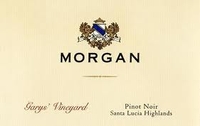 with sausage and tomato, finished with cream and cheese--was itself as rich and sensuous as the wine. I cannot deny that the alternate red wine was equally delicious with the pasta, but what surprised us all was the way that two wines from opposite ends of the taste spectrum could both be so satisfying, each in its own way, with a single dish. (The white wine was Dirler Grand Cru “Saering” 2004; the red Morgan 2007 Pinot Noir, Gary’s Vineyard, Santa Lucia Highlands, $48.) with sausage and tomato, finished with cream and cheese--was itself as rich and sensuous as the wine. I cannot deny that the alternate red wine was equally delicious with the pasta, but what surprised us all was the way that two wines from opposite ends of the taste spectrum could both be so satisfying, each in its own way, with a single dish. (The white wine was Dirler Grand Cru “Saering” 2004; the red Morgan 2007 Pinot Noir, Gary’s Vineyard, Santa Lucia Highlands, $48.)
So, if you’re about to start your spring cleaning, consider cleaning out some of your assumptions about wine while you’re at it….
Posted by Marguerite Thomas at 11:23 AM
|
|
March 7, 2012
People choose a wine from a retail shelf for any number of reasons. They remember it fondly from a prior experience. Or perhaps it was a recommendation. Sometimes even the "critter" on the label makes a difference when the moment of truth arrives.
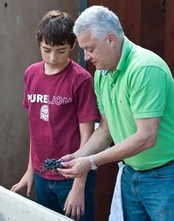 I've got a better idea. How about reaching for the one wine that is good for your heart, for everyone's heart. I've got a better idea. How about reaching for the one wine that is good for your heart, for everyone's heart.
That would be Colby Red, a delicious yet inexpensive California red wine crafted by the famed winemaker, Daryl Groom, with help from his 15-year-old son, Colby.
Colby was the inspiration for the wine — and, indeed, the entire project was his idea, after he survived a second open-heart surgery prior to his 13th birthday. The profits from Colby Red are donated to heart research, with more than $100,000 distributed so far, most of that going to the American Heart Association.
The second vintage of Colby Red is now in the market, and at 40,000 cases or so, the 2010 Colby is nearly double the production of the first vintage. Both vintages, however, have gone far beyond what either Groom envisioned at the outset.
"We made two barrels (about 50 cases) of wine," said Daryl. "We hoped to sell it at auction. But word got around what Colby and I were up to, and the idea just took off."
Enter the national drugstore chain Walgreen's, which offered to distribute the wine through its stores, and Treasury Wine Estates, the company that produces such brands as Chateau St. Jean, Beringer and Chateau Souverain, which lent its production facilities in northern Sonoma County for the suddenly more ambitious launch of the first Colby Red.
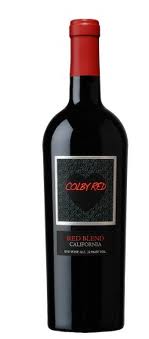 "This is a great wine," Groom says, almost with a tear in his eye. "And Colby's whole idea for it was so that other kids wouldn't have to go through a similar ordeal." "This is a great wine," Groom says, almost with a tear in his eye. "And Colby's whole idea for it was so that other kids wouldn't have to go through a similar ordeal."
When Daryl Groom talks about great wine, everyone should listen.
The native Australian has been making wine for more than 30 years, and from 1984 until 1989 he was the chief winemaker for Penfolds "Grange," Australia's most important wine. Groom came to the U.S. in 1990 to spearhead the turnaround of Sonoma County's Geyser Peak Winery, and within a couple of years Groom and his team made Geyser Peak one of the most award-winning wineries in the United States.
For the past five years or so, he's been making wine under his own label, Groom, from grapes grown in Australia's Barossa Valley and Adelaide Hills. Colby Red is a blend of cabernet sauvignon, zinfandel, syrah, merlot and petite sirah sourced from the North Coast appellations of Sonoma, Napa and Mendocino counties.
"As Colby Red grows, we may have to go outside that circle looking for fruit, perhaps Paso Robles, so the blend is likely to change somewhat from year to year," said Groom.
"The reception to this wine has been fantastic. It's the second-best selling wine at Walgreen's, and now we're beginning to sell it through other outlets. It's poured by the glass at Capitol Grill (in Washington, D.C.), and major retailers all over the country seem to be ready to jump in."
The Colby Red story is best told by those who lived it. There is a poignant seven-minute video that can be viewed at ColbyRed.com, as well as a short clip from the "Today" show. The website also offers Colby Red for sale online, for those who live in states where shipping is legal, and a meter that tracks the ongoing flow of funds that have been donated to heart research.
"I've had a great time traveling around the country handing out checks," Groom said. "What a feeling to be able to give away money, and to something so worthwhile."
Posted by Robert Whitley at 10:46 AM
|
|
 |
|